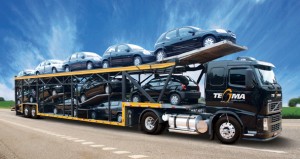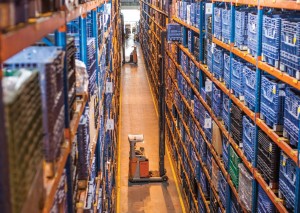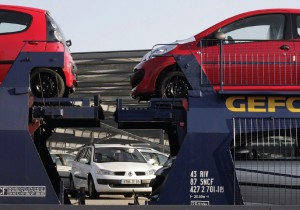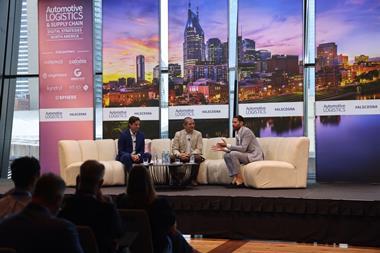As Brazil grapples with an uncertain economy and government-supported vehicle sales, logistics providers and automotive manufacturers are facing cost and infrastructure pressures that must be overcome
 Brazil’s automotive market has remained relatively buoyant despite the snag in its economy. However, as costs rise faster than growth in many parts of the supply chain, there is mounting pressure to improve logistics operations. A common complaint across the sector is about high costs relative to other countries, something generally referred to as the ‘custo Brasil’. Some OEMs are looking for ways to reduce cost through measures that are less common in the country, including the outsourcing of certain logistics network management functions.
Brazil’s automotive market has remained relatively buoyant despite the snag in its economy. However, as costs rise faster than growth in many parts of the supply chain, there is mounting pressure to improve logistics operations. A common complaint across the sector is about high costs relative to other countries, something generally referred to as the ‘custo Brasil’. Some OEMs are looking for ways to reduce cost through measures that are less common in the country, including the outsourcing of certain logistics network management functions.
With the FIFA World Cup and the Olympics set to be hosted over the coming years, there is some hope that Brazil’s government will invest in the ports, roads, airports and other infrastructure that the country lacks. Although recent protests across Brazil, targeted in part against the government’s failure to improve issues like traffic and public transport – even as it invests in stadiums – seems to have caught Brazilian officials offguard and could put more pressure on them to act.
Real GDP growth in Brazil was less than 1% in the first quarter of 2013, while inflation hovered around 6%. The government rolled out a series of tax exemptions that helped to kick-start car sales and these were unexpectedly extended to cheaper cars in the first quarter of this year.
According to Brazil’s carmakers association Anfavea, vehicle sales reached a record high in April after the government extended cuts to the IPI tax – which applies to manufactured goods – until the end of 2013. These measures offset fears that a tough global economic climate would hurt the nation’s industrial production. Brazilian car sales were up 9% in the first five months of the year, while production was also up by 17% to 1.44m.
As an indication of the impact this has had, US-based logistics provider Penske initially expected to achieve sales growth in 2013 of 5% compared to 2012. However, the first quarter has been stronger than expected and now the company is currently aiming to double that figure.
The government has begun to raise IPI tax rates on some vehicles, including on flex-fuel or gasoline engines under 1,000cc, which has been raised from 0% to 2% (but still below the original 7%). For engines between 1,000 and 2,000cc, the IPI has been increased from 5.5% to 7% (still below the original 11%). However, even with the tax rises, Brazilian car sales have been stronger than in other worldwide markets, says Paulo Sarti, Penske’s managing director in Brazil. “So far, we have not felt any impact [in lower sales] because of the government’s reaction.”
Notwithstanding the stuttering economic growth, Sarti says that carmakers have always kept a close eye on costs. However, he says, a change is also taking place. According to Sarti, carmakers are now not only recruiting logistics providers for core logistics tasks such as transport and warehousing, but also for other functions such as network management. “We used to carry out only transport and warehousing, but now we can offer complete solutions,” Sarti says. “The mentality is changing”.
Its Brazilian operations headquartered in São Paulo, Penske typically carries out warehousing, transport and material handling for OEMs such as Ford, Harley Davidson and General Motors. Brazilian-based OEMs used to think that key competencies were for their in-house teams only, but now it is becoming more important to look at ever-more complex services rather than just transport execution,
he adds.
"We used to carry out only transport and warehousing, but now we can offer complete solutions. The mentality is changing" – Paulo Sarti, Penske
Penske has handled complete network solutions before. It has worked for Ford and General Motors in the US and Mexico, running tasks such as logistics engineering, as well as managing milkruns and full truckloads. Such outsourcing to lead logistics providers was never common in Brazil but Penske recently won a contract to manage all of the material flows for an automotive client in the country, the name of which Sarti cannot yet disclose.
He says that although this OEM has the capability to analyse thousands of inbound and outbound routes and material flows, it is not able to manage the task everyday or in sufficient detail. However, Penske’s engineers – with the help of teams in the US or located in the customer’s plants – study all of the customer’s flows and then design its routes on an up-to-date basis. This brings various benefits; for example, the customer might discover that on a certain day it needs only one truck instead of three.
Sarti adds that a major challenge is to find skilled people for projects, particularly as Brazilian unemployment hovers around record low levels of about 5%. Penske’s operation in Brazil also used to draw on help from its teams in North America, but now that the American economy is picking up, these resources are needed elsewhere. Everyone faces challenges to find enough people and to train them adequately, he says.
Eyeing cost savings
Tier one manufacturer Delphi is also looking for cost savings in logistics. Rodrigo Palmieri, Delphi’s logistics manager in South America, says the company is focused on reducing its logistics costs for foreign trade, transport, product control and warehousing by around 20% in a few years. Delphi has 11 sites and three tech centres in Brazil and Argentina, and expects to ship 3.5m units of equipment this year in the region.
Palmieri says that suppliers must constantly find cost savings to mitigate logistics expenses. For instance, Delphi established RECOF/Blue Line in 2009 – a customer-controlled warehousing system which provides savings in duties for international trading activities. The system helps with import and export exchanges, as well as the control and management of special customs regimes.

Palmieri says that as Brazil’s import and export channels are infamously slow moving, it is essential to slash lead times for customs clearance. While companies in the US pass through customs in a few hours, in Brazil it can take anywhere from three to eight days.
Delphi usually works with a lead-time of 30-40 days for overseas suppliers to the Latin American region, however Palmieri says the system can cut this by 20%. “This system helps us to slash the time to get customs clearance,” he says.
As part of this drive, Delphi is also establishing a global transport management system to provide better knowledge about the company’s operations. This is being done by working with its global and local logistics providers, including Panalpina for overland freight between Brazil and Argentina, as well as for global air and maritime shipments. Delphi also works with Transportadora Pituta and Covre for domestic inbound and outbound activities and TNT for domestic outbound for the aftermarket. “The system, we hope, could be rolled out in Brazil in six months,” says Palmieri.
While Delphi is carrying out studies into how to improve logistics practices, it wants to safeguard its core knowledge in Brazil or the US. “As we usually outsource logistics activities every two or three years, it is important to keep this knowledge in-house,” he says.
"The arrival of new OEMs should encourage others to search for more efficient logistics models in collaboration with manufacturers in areas where they do not directly compete" – Richard Vietes, Ceva Logistics
Other companies are also carefully eyeing cost savings. Richard Vieites, senior vice-president and country manager for Brazil at Ceva Logistics, says as more OEMs establish a manufacturing presence in Brazil, they directly increase domestic competition. As a result, Vieites believes that new arrivals help to stimulate other OEMs into taking more intense measures to find efficiencies and cost reductions. For instance, for inbound and outbound logistics, some OEMs are starting to look more closely at collaboration with other manfacturers in areas where they do not directly compete. “This should be a greater priority in the search for more efficient logistics models,” he says.
Vieites explains that Ceva plans to attack growth opportunities in areas such as customs brokerage and ground transport, as well as trying to grow more organically with carmakers that it might work with in other regions.
Moreover, the company is looking at implementing new opportunities such as shared distribution-channel networks, as well as leveraging networks between inbound manufacturing flows and outbound aftermarket flows with OEMs. Ceva is also rolling out the group’s global freight system, which Vieites says will allow all of the Ceva entities around the world to communicate and follow a customer’s freight using a common platform, he adds.
 Chinese brands, such as JAC and Chery, have had to decide whether to continue to import vehicles under higher tariffs or to build local assembly plants
Chinese brands, such as JAC and Chery, have had to decide whether to continue to import vehicles under higher tariffs or to build local assembly plants Indeed, despite the weak growth in the Brazilian economy in 2012, Brazil’s largest vehicle logistics provider, Tegma, still sees large potential for the next 4-5 years and is searching for new clients to improve its service offering and quality. To support overall growth in the country, Tegma’s chief executive, Gennaro Oddone, says it aims to adjust its operations, mainly to ensure that the company is strategically located, including next to OEM plants, where possible.
According to Oddone, Tegma usually needs to adapt its operations after winning a new contract. This could mean providing parking patios close to the new collection points for vehicles or reallocating the fleet, he says. For instance, contracts were recently signed with Hyundai and Toyota that require the acquisition of patios and exactly such a reallocation of trucks and vehicles.
Tegma has invested R$47.9m ($22.26m) in new equipment and to adapt the leaseholdings for operations in the automotive and consumer goods sectors. The company has 78 units across Brazil; 5,086 direct collaborators; 4,711 items of its own or outsourced equipment; over 2m square metres of patios; and 125,000 square meters of storage space.
Infrastructure reforms rumble on
Despite often chaotic infrastructure conditions, with kilometres of lorries queuing outside ports or dozens of vessels waiting offshore to berth, logistics experts say infrastructure is now on the government’s agenda. Following years of underinvestment, particularly relative to other emerging economies, there seems to be a realisation that urgent investment is required to enable productivity.
Indeed, Brazil has a variety of high-profile port working groups and politicians who have tried, with varying success, to push a bill through Congress to change the rules on private investment. Meanwhile, the government is encouraging banks to finance projects that are related to infrastructure.
Although experts praised the government for spending, they remain sceptical about the speed of investment required to keep up with the country’s industrial production. Major events such as the FIFA World Cup in 2014 and the Olympics in 2016 will also cast an intense spotlight on Brazil.

Ceva’s Vieites explains that an example of such an initiative is the ‘Brasil Maior’ industrial policy. The objective of the plan for 2011-14 is a series of measures designed to boost chosen industrial segments, including the automotive sector. The government is also attempting to alleviate some barriers through short-term measures such as 24-hour port operations. However, many hurdles will only be removed by increased infrastructure investment in the long term.
To benefit from the gains, Ceva is actively looking for opportunities to overcome some of the challenges. “We are using modal shift analysis and other initiatives such as night-time distribution to increase equipment utilisation,” Vietes says.
But concerns remain. Penske’s Sarti believes that there is insufficient government expertise and a lack of manpower. “[The government] cannot act fast enough,” he says. In terms of airports, the World Cup in 2014 has given a boost to investment and the licenses have already been sold for key airport projects, but roads will take more time, he warns – and rail developments are likely to take many years.
Restrictions on the road
Logistics providers are also grappling with new rules on the length of time drivers can work. Work trips have now been restricted to eight hours a day and 30-minute breaks are needed every four hours. This restricts the numbers of hours worked and requires rest stops on highways.
Logistics experts say the government wanted to implement the rules quickly, even though some motorways and roads do not have the necessary rest stops, which often means that lorries need two drivers to complete long trips. The government, according to Penske’s Sarti, has so far been relatively lenient and has even waived fines as they realised the legislation was difficult to follow.
"After signing new contracts such as those with Hyundai and Toyota, we will adapt our operations by reallocating our fleet or acquiring new patios in strategically optimal locations" – Gennaro Oddone, Tegma
Luiz Alcântara, Gefco’ Brazil’s director of overland operations, warns that the legislation still needs adjustments to run well. The rules have led to longer working hours and longer lead times between Brazil and Argentina, for instance. He says that up to two days have been added to a typical journey and productivity has been squeezed by some 25%-30%. Subsequently, vehicle costs and labour costs rose, he says.
Although it is necessary for improved working conditions, the legislation is bureaucratic and lacks sufficient initiatives to implement its projects. “This can be seen by the investments in infrastructure that still haven’t taken off yet,” Alcântara says.
That’s a refrain familiar in Brazil. Indeed, manufacturers and logistics providers hoping that the World Cup and Olympics might give them more of the infrastructure they desire may well be waiting until long after the games are over.





































